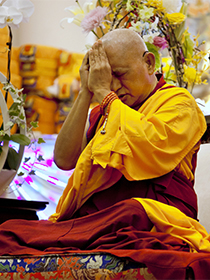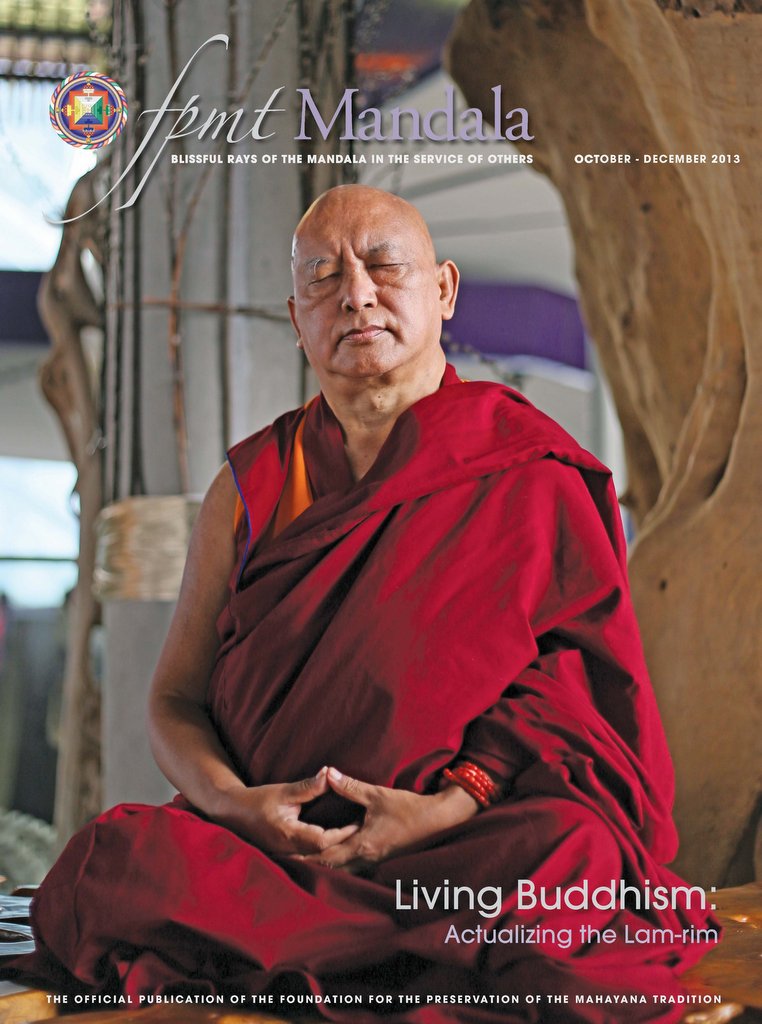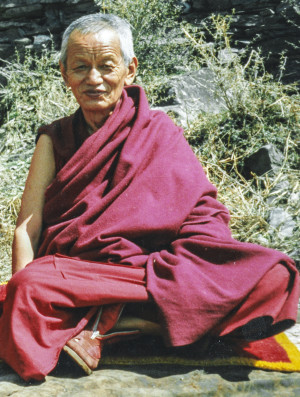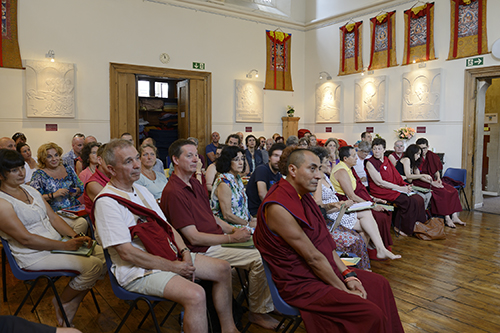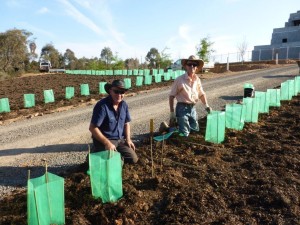- Home
- FPMT Homepage
Foundation for the Preservation of the Mahayana Tradition
The FPMT is an organization devoted to preserving and spreading Mahayana Buddhism worldwide by creating opportunities to listen, reflect, meditate, practice and actualize the unmistaken teachings of the Buddha and based on that experience spreading the Dharma to sentient beings. We provide integrated education through which people’s minds and hearts can be transformed into their highest potential for the benefit of others, inspired by an attitude of universal responsibility and service. We are committed to creating harmonious environments and helping all beings develop their full potential of infinite wisdom and compassion. Our organization is based on the Buddhist tradition of Lama Tsongkhapa of Tibet as taught to us by our founders Lama Thubten Yeshe and Lama Thubten Zopa Rinpoche.
- Willkommen
Die Stiftung zur Erhaltung der Mahayana Tradition (FPMT) ist eine Organisation, die sich weltweit für die Erhaltung und Verbreitung des Mahayana-Buddhismus einsetzt, indem sie Möglichkeiten schafft, den makellosen Lehren des Buddha zuzuhören, über sie zur reflektieren und zu meditieren und auf der Grundlage dieser Erfahrung das Dharma unter den Lebewesen zu verbreiten.
Wir bieten integrierte Schulungswege an, durch denen der Geist und das Herz der Menschen in ihr höchstes Potential verwandelt werden zum Wohl der anderen – inspiriert durch eine Haltung der universellen Verantwortung und dem Wunsch zu dienen. Wir haben uns verpflichtet, harmonische Umgebungen zu schaffen und allen Wesen zu helfen, ihr volles Potenzial unendlicher Weisheit und grenzenlosen Mitgefühls zu verwirklichen.
Unsere Organisation basiert auf der buddhistischen Tradition von Lama Tsongkhapa von Tibet, so wie sie uns von unseren Gründern Lama Thubten Yeshe und Lama Thubten Zopa Rinpoche gelehrt wird.
- Bienvenidos
La Fundación para la preservación de la tradición Mahayana (FPMT) es una organización que se dedica a preservar y difundir el budismo Mahayana en todo el mundo, creando oportunidades para escuchar, reflexionar, meditar, practicar y actualizar las enseñanzas inconfundibles de Buda y en base a esa experiencia difundir el Dharma a los seres.
Proporcionamos una educación integrada a través de la cual las mentes y los corazones de las personas se pueden transformar en su mayor potencial para el beneficio de los demás, inspirados por una actitud de responsabilidad y servicio universales. Estamos comprometidos a crear ambientes armoniosos y ayudar a todos los seres a desarrollar todo su potencial de infinita sabiduría y compasión.
Nuestra organización se basa en la tradición budista de Lama Tsongkhapa del Tíbet como nos lo enseñaron nuestros fundadores Lama Thubten Yeshe y Lama Zopa Rinpoche.
A continuación puede ver una lista de los centros y sus páginas web en su lengua preferida.
- Bienvenue
L’organisation de la FPMT a pour vocation la préservation et la diffusion du bouddhisme du mahayana dans le monde entier. Elle offre l’opportunité d’écouter, de réfléchir, de méditer, de pratiquer et de réaliser les enseignements excellents du Bouddha, pour ensuite transmettre le Dharma à tous les êtres. Nous proposons une formation intégrée grâce à laquelle le cœur et l’esprit de chacun peuvent accomplir leur potentiel le plus élevé pour le bien d’autrui, inspirés par le sens du service et une responsabilité universelle. Nous nous engageons à créer un environnement harmonieux et à aider tous les êtres à épanouir leur potentiel illimité de compassion et de sagesse. Notre organisation s’appuie sur la tradition guéloukpa de Lama Tsongkhapa du Tibet, telle qu’elle a été enseignée par nos fondateurs Lama Thoubtèn Yéshé et Lama Zopa Rinpoché.
Visitez le site de notre Editions Mahayana pour les traductions, conseils et nouvelles du Bureau international en français.
Voici une liste de centres et de leurs sites dans votre langue préférée
- Benvenuto
L’FPMT è un organizzazione il cui scopo è preservare e diffondere il Buddhismo Mahayana nel mondo, creando occasioni di ascolto, riflessione, meditazione e pratica dei perfetti insegnamenti del Buddha, al fine di attualizzare e diffondere il Dharma fra tutti gli esseri senzienti.
Offriamo un’educazione integrata, che può trasformare la mente e i cuori delle persone nel loro massimo potenziale, per il beneficio di tutti gli esseri, ispirati da un’attitudine di responsabilità universale e di servizio.
Il nostro obiettivo è quello di creare contesti armoniosi e aiutare tutti gli esseri a sviluppare in modo completo le proprie potenzialità di infinita saggezza e compassione.
La nostra organizzazione si basa sulla tradizione buddhista di Lama Tsongkhapa del Tibet, così come ci è stata insegnata dai nostri fondatori Lama Thubten Yeshe e Lama Zopa Rinpoche.
Di seguito potete trovare un elenco dei centri e dei loro siti nella lingua da voi prescelta.
- 欢迎 / 歡迎
简体中文
“护持大乘法脉基金会”( 英文简称:FPMT。全名:Foundation for the Preservation of the Mahayana Tradition) 是一个致力于护持和弘扬大乘佛法的国际佛教组织。我们提供听闻,思维,禅修,修行和实证佛陀无误教法的机会,以便让一切众生都能够享受佛法的指引和滋润。
我们全力创造和谐融洽的环境, 为人们提供解行并重的完整佛法教育,以便启发内在的环宇悲心及责任心,并开发内心所蕴藏的巨大潜能 — 无限的智慧与悲心 — 以便利益和服务一切有情。
FPMT的创办人是图腾耶喜喇嘛和喇嘛梭巴仁波切。我们所修习的是由两位上师所教导的,西藏喀巴大师的佛法传承。
繁體中文
護持大乘法脈基金會”( 英文簡稱:FPMT。全名:Found
ation for the Preservation of the Mahayana Tradition ) 是一個致力於護持和弘揚大乘佛法的國際佛教組織。我們提供聽聞, 思維,禪修,修行和實證佛陀無誤教法的機會,以便讓一切眾生都能 夠享受佛法的指引和滋潤。 我們全力創造和諧融洽的環境,
為人們提供解行並重的完整佛法教育,以便啟發內在的環宇悲心及責 任心,並開發內心所蘊藏的巨大潛能 — 無限的智慧與悲心 – – 以便利益和服務一切有情。 FPMT的創辦人是圖騰耶喜喇嘛和喇嘛梭巴仁波切。
我們所修習的是由兩位上師所教導的,西藏喀巴大師的佛法傳承。 察看道场信息:
- FPMT Homepage
- News/Media
-
- Study & Practice
-
-
- About FPMT Education Services
- Latest News
- Programs
- New to Buddhism?
- Buddhist Mind Science: Activating Your Potential
- Heart Advice for Death and Dying
- Discovering Buddhism
- Living in the Path
- Exploring Buddhism
- FPMT Basic Program
- FPMT Masters Program
- FPMT In-Depth Meditation Training
- Maitripa College
- Lotsawa Rinchen Zangpo Translator Program
- Universal Education for Compassion & Wisdom
- Online Learning Center
-
- Prayers & Practice Materials
- Overview of Prayers & Practices
- Full Catalogue of Prayers & Practice Materials
- Explore Popular Topics
- Benefiting Animals
- Chenrezig Resources
- Death & Dying Resources
- Lama Chopa (Guru Puja)
- Lama Zopa Rinpoche: Compendium of Precious Instructions
- Lama Zopa Rinpoche: Life Practice Advice
- Lama Zopa Rinpoche Practice Series
- Lamrim Resources
- Mantras
- Prayer Book Updates
- Purification Practices
- Sutras
- Thought Transformation (Lojong)
- Audio Materials
- Dharma Dates - Tibetan Calendar
- Translation Services
- Publishing Services
- Ways to Offer Support
- Prayers & Practice Materials
-
- Teachings and Advice
- Find Teachings and Advice
- Lama Zopa Rinpoche Advice Page
- Lama Zopa Rinpoche: Compendium of Precious Instructions
- Lama Zopa Rinpoche Video Teachings
- ༧སྐྱབས་རྗེ་བཟོད་པ་རིན་པོ་ཆེ་མཆོག་ནས་སྩལ་བའི་བཀའ་སློབ་བརྙན་འཕྲིན།
- Podcasts
- Lama Yeshe Wisdom Archive
- Buddhism FAQ
- Dharma for Young People
- Resources on Holy Objects
- Teachings and Advice
-
-
*If a menu item has a submenu clicking once will expand the menu clicking twice will open the page.
-
-
- Centers
-
- Teachers
-
- Projects
-
-
-
-
*If a menu item has a submenu clicking once will expand the menu clicking twice will open the page.
-
-
- FPMT
-
-
-
-
-
Try to eliminate the negative attitudes, which bring suffering, and increase the positive attitudes, which bring happiness.
Lama Zopa Rinpoche
-
-
-
- Shop
-
-
-
The Foundation Store is FPMT’s online shop and features a vast selection of Buddhist study and practice materials written or recommended by our lineage gurus. These items include homestudy programs, prayers and practices in PDF or eBook format, materials for children, and other resources to support practitioners.
Items displayed in the shop are made available for Dharma practice and educational purposes, and never for the purpose of profiting from their sale. Please read FPMT Foundation Store Policy Regarding Dharma Items for more information.
-
-
Mandala
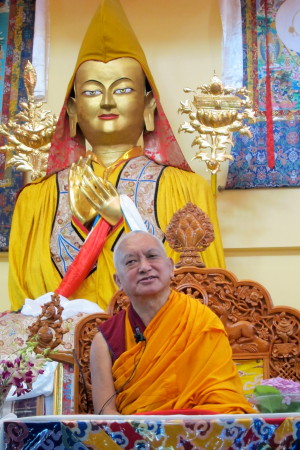
Lama Zopa Rinpoche teaching at Tushita Meditation Centre, Dharamsala, India, June 2013. Photo by Ven. Sarah Thresher.
In Mandala October-December 2013, Lama Zopa Rinpoche responds to a long-time student who wrote to Rinpoche in thanks for his “blessings, guidance and protection” over many years. The anonymous student currently takes care of her mother who suffers physically after a series of strokes. As a method to deal with the challenges of caregiving, the student visualizes taking care of Rinpoche when taking care of her mother.
“I know I have not developed special qualities,” concludes the student. “Without your teachings, without your example and blessings, without your guidance and protection, it would have been unbearable to face all this.”
First of all, it is really great the meditation you are doing: serving your mother and thinking you are serving the guru. When I was in Tibet (not the last time, but the time before) our journey took us to Reting, Lama Dromtönpa’s monastery, which he built on the advice of Lama Atisha. I didn’t know, but our guide directed the tour through His Holiness the Karmapa’s monastery in Tshurpu. We stayed there one day and slept outside the monastery in tents for two nights. I went to visit nearly every temple in the monastery. The monks were doing puja and I personally made money offering to each one, handing them the money myself. As I did this, I started to think that each one was my guru, His Holiness Trijang Rinpoche or Lama Yeshe (maybe the first one). This is what I was thinking as I gave the money, so I collected the most extensive merits and accumulated the most powerful purification because I was thinking of each monk as the guru.
So first of all, this life’s parents are very powerful objects of merit. Even very small negative or positive actions done towards this life’s parents are extremely powerful. Therefore, as a result of offering service to your mother, you will have so much happiness even in this life, your wishes will succeed and you will have a very good life. And the result is experienced not only this life; each positive action of offering service that you create towards the parents will bring benefit for thousands of lifetimes. It brings a good rebirth and unbelievable, unbelievable, unbelievable happiness while you are in samsara. I’m talking about each small service; every one results in happiness for thousands of lifetimes. So can you imagine the result of twenty-four hours of service? Wow, wow, wow, wow, wow, wow. Then, if the service is done with bodhichitta, each one is the cause of enlightenment. The merit of every small service, every virtue created is so powerful. …
From Mandala October-December 2013
If you like what you read on Mandala, consider becoming a Friend of FPMT, which supports our work.
- Tagged: mandala, teachings and advice
- 0
9
Achieving Realizations of the Path
Lama Zopa Rinpoche has recently been commenting on the need for FPMT students to actualize the lam-rim teachings and achieve realizations. You can read Rinpoche’s recent advice in the just-published Mandala October-December 2013:
Special group of retreatants
First of all, I want to say that the FPMT has been developing now for many years and over that time people have been studying and practicing the Dharma according to their ability. Generally, when I look at the FPMT organization, what I see is that the students have developed more compassion and good-heartedness. This is extremely worthwhile because compassion for all sentient beings is the very heart of Buddhism; it is the most important Dharma practice for the happiness of the individual students, for their families, for society, for the country, for the world and for the six realms’ sentient beings.
There has been a lot of study and the study is going well; there is Discovering Buddhism, the Basic Program and the Masters Program. Particularly in the Gelugpa tradition there is a lot of teaching and learning philosophy, and in the FPMT organization we have been doing that. Buddhist philosophy is now being studied in almost every center, especially where there is a resident geshe. We even have Western students who have completed the Masters Program and can teach philosophy where there is no geshe, or even where there is a geshe. There are more centers teaching the Masters Program and some centers have already taught the Basic Program several times. People have been learning about Buddhism, and especially the lam-rim, for quite some time now in the FPMT and there are some who are also trying to meditate and practice the lam-rim.
Now what is needed are people who will sacrifice their lives, as they did in India, Tibet and Nepal, not just to study the Dharma like at a college or university, but to actualize the teachings in a monastery or isolated place. In Tibet, the mountains were full of caves like ants’ nests, where people would go to practice without distraction. When I came from Solu Khumbu [in Nepal] to Tashi Lhunpo Monastery in Tsang [Tibet] and then on to Pagri [in Tibet] there were many caves along the road where meditators would practice with hardship and the realizations of guru devotion, renunciation, bodhichitta, right view and the two stages of tantra would all come. Wow, wow, wow. It’s unbelievable! That’s why the country of Tibet is so blessed and so precious because there are many, many caves where meditators, like Milarepa, for example, achieved different realizations, such as the rainbow body.
This is how Buddhism really comes alive – when it is not just words, not just scholars, but really living Buddhism. When study and realization come together, Buddhism will really last. Wow, then like an ocean in the heart and the mind, it will spread and be preserved. …
From Mandala October-December 2013
If you like what you read on Mandala, consider becoming a Friend of FPMT, which supports our work.
- Tagged: mandala, teachings and advice
- 0
6
The Exemplary Life and Death of Geshe Yeshe Tobden
Many long-time students of Lama Yeshe and Lama Zopa Rinpoche in Dharamsala, India, and also in Italy may remember Geshe Yeshe Tobden, who was a remarkable meditator and yogi and who died in July 1999. Geshe-la’s former attendant, Ven. Lobsang Dhonden, shared some of Geshe-la’s life story in Mandala June 2001:
“Geshe Yeshe Tobden had escaped from Tibet by himself in 1960-61 after years of terror and Communist occupation. He was already well known in his monastery in Tibet – Sera Me – because of his very strict and rigorous practice. He was like St. Francis; he lived according to a very strict discipline, in poverty, humility, and chastity. Thousands of monks knew him and called him a saint from that time. Even the Chinese respected him.
“ … His Holiness the Dalai Lama sent him to the university of Varanasi to teach Buddhist philosophy for three years. But Geshe-la was not happy there because his highest aspiration was to meditate in a small grotto on the mountain. At that time the conditions to be able to do it were truly difficult. All geshes could not go away to the mountains, and thus Geshe-la submitted to the wish of His Holiness and went to Varanasi.
“In Varanasi there were many other important geshes, among them Geshe Rabten who came to know of Geshe Tobden’s profound desire. One day, while in discussion with His Holiness, he had the chance to talk to him about it. His Holiness then saw Geshe Tobden personally, asking him if he still wanted to go to the mountain and what he would do there once by himself. And Geshe-la said that he would like so much to meditate on renunciation, bodhichitta and emptiness.
“His Holiness greatly appreciated Geshe-la’s genuine desire and proposed that he go to Dharamsala, saying that he would take care of Geshe-la’s material needs, would talk to the director of the university in Varanasi and ask for the collaboration of the Indian state so that Geshe-la would be released from his teaching duties before the end of his contract. Geshe-la was able to leave immediately.
“From that time on he would be considered as a member of the Dalai Lama’s own family; His Holiness would always have time to receive him, regardless of his duties. Geshe-la was so happy. The other professors asked him not to go and leave the nice house and a very good salary, one of the highest, higher than that of the minister of the provisional Tibetan government. He was living a good life in Varanasi, worked relatively little and wanted to leave all that! In the eyes of the other professors he seemed a little eccentric. …”
You can read Ven. Lobsang Dhonden’s complete article “The Exemplary Life and Death of Geshe Yeshe Tobden” from Mandala June 2001 in Mandala’s online archive.
If you like what you read on Mandala, consider becoming a Friend of FPMT, which supports our work.
- Tagged: from the vault, geshe yeshe tobden, mandala
- 0
6
By Ven. Chönyi Taylor
Food. It occupies a lot of my mind. In fact it always has, but more so since I was diagnosed with diabetes (Type 2, no big deal). So I wonder again, as I have many times in the past, how much easier life would be if we did not have to eat. This is possible in science fiction, and, as I found out after many years, for some Tibetan yogis: a complete food substitute in a pill.
This gives a new meaning to “the pill” – not a contraceptive, but a no-sugar, instant energizer that helps us diabetics. It is available from Tibetans, made from flowers amongst other ingredients and called chulen. Unfortunately, the energizing effect of this pill takes some times to kick in and one also needs a very good motivation for it to work … and some pretty good positive karma as well.1
There are three kinds of chulen: flower chulen, stone chulen and water chulen. With flower chulen, there is a pill composed of many different kinds of flowers; you take three pills: one in the morning, one at lunch, and one at night. That is all you eat, and it is sufficient. Then, when you get used to it, one pill is enough. And when you’re totally used to that, you don’t need to eat at all – you just use the visualization and absorb the elements directly into yourself. The energy itself is sufficient to sustain you.
When you do chulen you generate yourself as the deity, then you take the pill and you visualize taking the essence of the five elements – earth, air, fire, water and space. You absorb the essence of them into yourself. By doing this you don’t have to rely on any raw food at all.
For Dharma practitioners, doing a chulen retreat helps you not waste time. You don’t waste time gathering the food together and cooking it, which means you have more free time to practice Dharma, especially when you go do retreat in a cave. You don’t need to rely on a benefactor to sponsor the food. And moreover it makes your mind extremely clear. It helps the energy in the meditation. The secondary benefit is that it prolongs your lifespan and it reduces your gray hair and wrinkles. It also makes your face and body more beautiful.”2
It takes a lot of time to shop, prepare and cook food for a family. I used to think how much more spare time I would have if none of us needed to eat. Of course, this would disrupt a massive industry that relies not just on the need to eat, but also on the greed to eat. Millions of stores would become redundant. Even more millions of people would be out of work. On the other hand, there would be no looming food crises due to wars and climate change. What would we all do with so much time?
Our human history does not indicate we would use it well.
On the other hand, think of all the negative karma we create by grasping for food. None of this would occur. Our whole digestive system, which occupies a large proportion of our bodies, would become obsolete.
The Tibetan creation story tells us that we devolved from beings of light into beings with coarse human bodies because we became greedy for food. At first we had given to us exactly what we needed for one day. Then someone became frightened that the food would not arrive the next day and stole his neighbor’s food. The neighbor then needed to steal from another person and so on until everyone was hoarding their food supplies and protecting their hoards.3 I suppose that if we were given a daily magic pill, we would end up doing exactly the same. Back to reality. I need to eat, which means I need to shop, prepare and cook food.
Not only do I need to eat, but my metabolic state means I need to eat mindfully. There are the meditations on mindful eating in which we take note of every moment of tasting and chewing food. Mindful eating, though, also means mindful shopping and mindful food preparation. I need to ask, Where is the dreaded sugar? Mindful shopping means reading the labels carefully and knowing the disguises under which sugar hides. Mindfulness, then needs to be supported by wisdom.
Another important form of food mindfulness is becoming aware of the difference between being hungry and wanting to eat. Then there is the mindfulness of my reactions to refusing myself what I would like to eat. Mindfulness of the discomfort that follows. Mindfulness of the source of my discomfort. Mindfulness of my ego. Mindfulness of the source of my ego. Mindfulness of its non-inherent existence.
Maybe it is a good thing that I have diabetes if it brings me back to mindfulness of non-inherent existence.
Ven. Chönyi Taylor is a registered Foundational Buddhism FPMT teacher and an elder for the Discovering Buddhism at Home Course. She is the author of Enough! A Buddhist Approach to Working with Addictive Patterns (Snow Lion, 2010) and has been published in Mandala, Buddhadharma, Dharma Vision and Sangha Magazine. She is a founding member and member of the training committee of the Australian Association of Buddhist Counsellors and Psychotherapists and an Honorary Lecturer in the Discipline of Psychiatry at Sydney University.
1. You can read one first-hand experience of being on “the pill” at https://www.lamayeshe.com/?sect=article&id=489
2. See Choden Rinpoche, http://www.kurukulla.org/program/choden_articles/revolution.html
- Tagged: food, ven. chonyi taylor
- 0
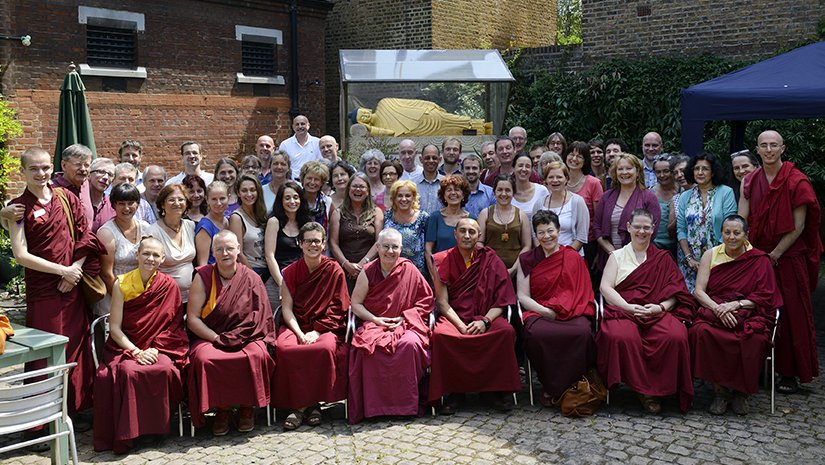
Participants in European Regional Meeting, Jamyang Buddhist Centre, July 2013. Photo by Natascha Sturny.
Jamyang Buddhist Centre London “hosted a successful and very happy Europe Region Annual meeting in July,” wrote Jamyang’s Adnan Hadzi.
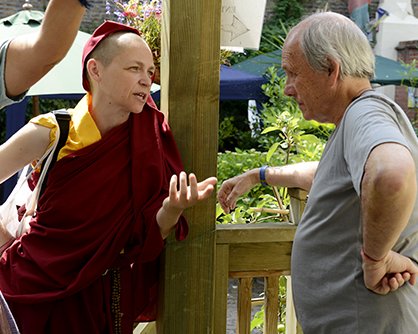
Meeting delegates enjoy the sun and a chance to talk, Jamyang Buddhist Centre, July 2013. Photo by Natascha Sturny.
“Sixty delegates from 15 countries in Europe met to discuss the benefits of five-year rolling plans, how they could improve their governance and improve the range of courses they offer, and to formulate plans for their groups for next year. It was very inspiring meeting our FPMT family members from all over Europe,” Adnan wrote.
Jamyang also shared some great photos from the event with Mandala.
Mandala brings you news of Lama Zopa Rinpoche and FPMT activities, teachers and events from over 160 FPMT centers, projects and services around the globe. If you have news you would like to share, please let us know.
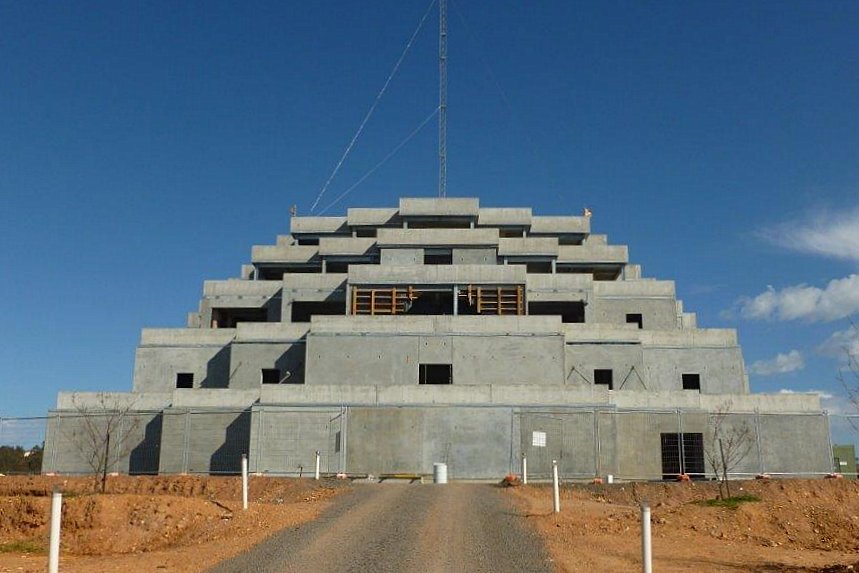
Great Stupa of Universal Compassion, Victoria, Australia, August 2013. Photo courtesy of Ian Green via Twitter.
The Great Stupa of Universal Compassion continues to rise from the bush of Victoria, Australia. The massive project has been captured in an impressive new video that shows the current development of the 50-meter [164-foot] stupa in Maiden Gully, near Bendigo.
Video: Great Stupa of Universal Compassion
The video was shot by a camera attached to a “mini-drone,” providing amazing aerial views of the grounds and stupa, which when completed will be the same size and design as the Great Stupa of Gyantse in Tibet and will house a gompa, many large holy statues as well as sacred relics. In addition to construction on the stupa, workers are busy with planting and landscaping the grounds. Rosemary and lavender are currently being planted.
The development of the Great Stupa began in the mid-1990s. Ian Green, a long-time student of Lama Yeshe and Lama Zopa Rinpoche, directs the $20-million project. In a 2011 interview with Mandala, he talked about the history of the site, its progress and his involvement with FPMT.
Reflecting on the project’s pace of development, Ian said, “Rinpoche has commented that the way the Great Stupa has been built is a good example for other major projects to follow. He described our careful, steady progress as being like an aircraft on a runway which takes quite a while to get to maximum speed before taking off and soaring to great heights. He said, and I agree totally with him, that the biggest danger is to leap into things before you are prepared. These leaps can lead to crashes which can set major projects back for a very long time. Unfortunately, first impressions really do last a very long time.”
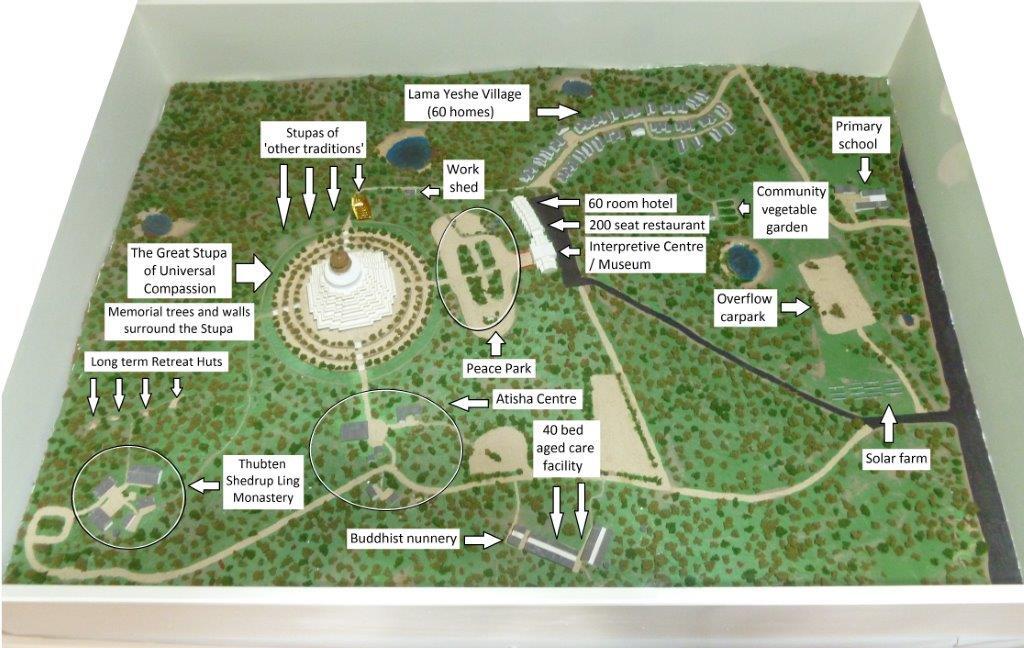
Three-dimensional model of master plan for development at Great Stupa. Image courtesy of Ian Green via Twitter.
Atisha Centre and Thubten Shedrup Ling share the large grounds with the stupa and are integral to the flowering of the vast long-range vision of a Buddhist community, which Ian describes in the interview and can be seen in a three-dimensional model of the master plan for the site, currently with the local Bendigo Council.
You can find more photos and news from the Great Stupa on Twitter and Facebook. For more information on the project, visit the Great Stupa’s website.
Mandala brings you news of Lama Zopa Rinpoche and FPMT activities, teachers and events from over 160 FPMT centers, projects and services around the globe. If you have news you would like to share, please let us know.
- Tagged: great stupa of universal compassion, ian green, mandala
- 0
3
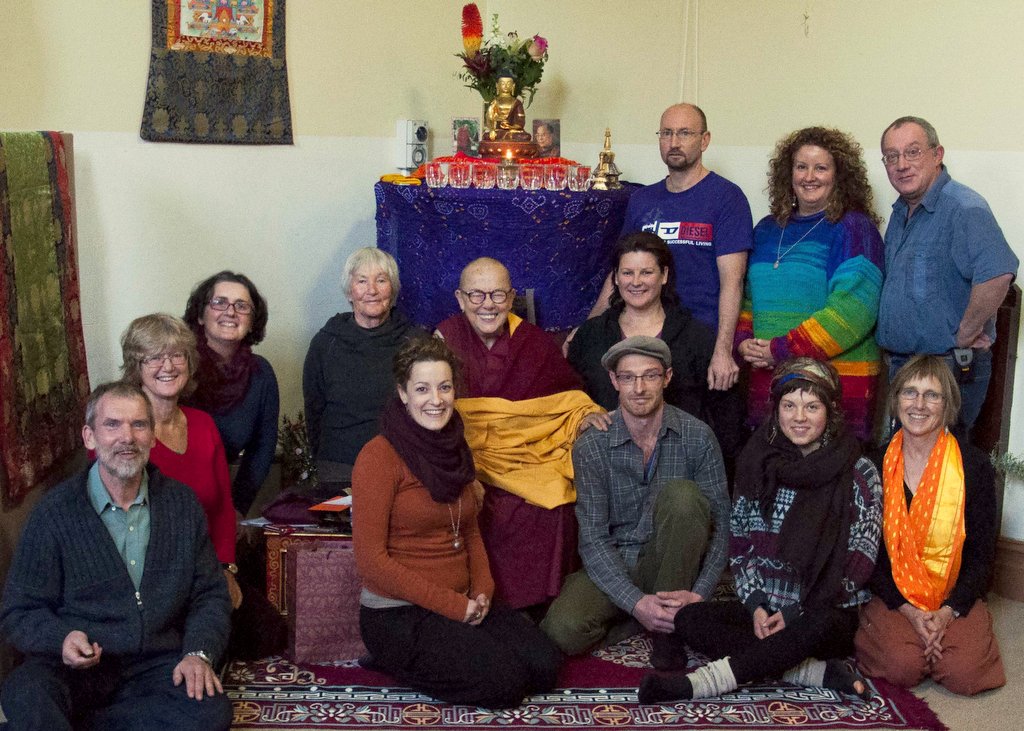
Ven. Robina Courtin with members of Shen Phen Ling Study Group, Victoria, Australia, June 2013. Photo courtesy of Shen Phen Ling Study Group.
Shen Phen Ling Study Group, based in Albury/Wodonga, Victoria, Australia, hosted Ven. Robina Courtin in late June. Ven. Robina gave a weekend teaching on “Courageous Compassion” in the small rural town of Yackandandah, located in northeastern Victoria, not far from Albury/Wodonga. For the teaching event, study group members transformed an old courthouse into a beautiful gompa.
An “eclectic assortment of people” turned up for the teaching. In addition to more experience students, a few people with no prior experience with Buddhism attended. “Taking it all in her stride, Ven. Robina presented an engaging discussion that weaved in humor, personal experience and audience participation,” study group coordinator Julie Klose shared with Mandala. The audience was inquisitive and participated in energetic and topical debate Julie reported.
“After covering the fundamentals of wisdom on Saturday, Sunday’s teaching focused more on compassion and great compassion. Not only did we get valuable individual advice and guidance over the weekend, but we also gratefully received instruction and guidance for our small bur keen study group,” Julie wrote.
Mandala brings you news of Lama Zopa Rinpoche and FPMT activities, teachers and events from over 160 FPMT centers, projects and services around the globe. If you have news you would like to share, please let us know.
27
Mind Training, The Tibetan Tradition of Mental and Emotional Cultivation: Part II
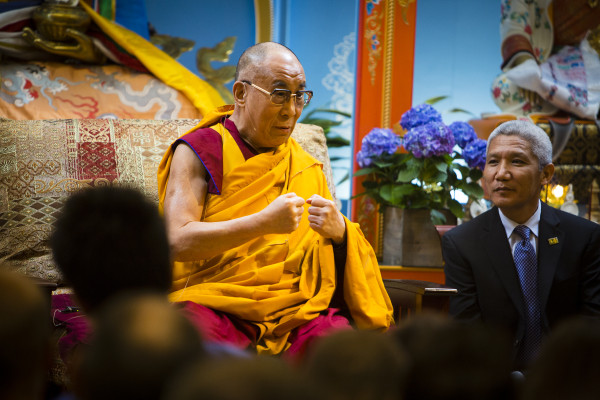
His Holiness the Dalai Lama and translator Thupten Jinpa in the Jokhang at Maitripa College, May 10, 2013. Photo by Leah Nash.
Scholar and chief translator for His Holiness the Dalai Lama, Geshe Thupten Jinpa, continues his discussion of the Tibetan tradition of mind training, which forms the basis of his important book Mind Training: The Great Collection.
One of the key themes of mind training [lo-jong] practices is a radical re-orientation of our personality, attitudes, and thoughts. The idea is that we can re-orient our very being, so that we can shift from our habitual self-centeredness to other-centeredness.
Mind training begins with an emphasis on cultivating a completely new way of relating to other beings. As Geshe Langri Tangpa (1054-1123) says in his Eight Verses for Training the Mind, “May I be able to perceive all others as true friends, as precious as a wish-granting jewel.” So when we see others, we try to see them as a source of our well-being. We see them with a perspective of gratitude, and we recognize that for our own happiness, for our own well-being, the presence of others is indispensable.
Mind training practice (lo-jong) is a down-to-earth, practical approach. Because Buddhism is as much a philosophy as it is a religion, sophisticated philosophizing sometimes arises. Lo-jong is quite suspicious of this tendency, and sometimes deliberately eschews or rejects any form of systematization. So this mind training approach is a way of practicing whatever is most appropriate at any given moment, emphasizing that which is most relevant to your current situation.
From Manadala February-March 2008
23
Cherishing Life and a Recipe for Mushroom and Kale Pâté

Special guests visit The Cheese Plate PDX, May 2013, Portland, Oregon, U.S. Photo courtesy of The Cheese Plate PDX.
Inspired by Lama Zopa Rinpoche’s message to students in FPMT Annual Review 2011: Cherishing Life, FPMT International Office’s Carina Rumrill – former editor of Mandala and present editorial support for the office – and her partner, Nick Dickison, took their extensive experience in fine dining, combined it with Portland, Oregon’s increasingly popular food cart scene and created The Cheese Plate PDX. The high-end-style food cart has a carefully thought-out vegetarian menu, with many vegan choices, that reflects the importance Rinpoche places on a vegetarian diet.
In the letter, Rinpoche, who manifested a stroke in April 2011, reflected:
When I was in the hospital, I saw a program about animals that were sold to be killed in Indonesia and other countries for live export … It didn’t show how they were killed, but it showed one cow that was on the platform, with the head tied, being pulled down to be killed. The cow didn’t want to go and the man was pulling it. I thought, “I don’t have power to stop all this killing, but what I can do is to try to inspire people to become vegetarian.”
Read more, plus find a recipe for mushroom and kale pâté …
From Mandala July-September 2013
22

Geshe Ngawang Dakpa checking the torma for Padmasambhava incense puja, Land of Medicine Buddha, California, August 13, 2013. Photo by Dionne Wilson; courtesy of LMB’s Facebook page.
Land of Medicine Buddha (LMB) in Soquel, California, has had a busy summer. In June, they celebrated their Eleventh Medicine Buddha Festival Day, which also included a visit from the Maitreya Heart Shrine Relic Tour. Hundreds of people attended the festival. Lama Zopa Rinpoche attended in 2008 and gave much encouragement and advice, which LMB each year reviews and works to fulfill.
Denice Macy, LMB’s director, wrote, “The accomplishment this year was following Rinpoche’s advice to ‘have many performers, not just one or two.’ By following Rinpoche’s advice, we found that people stayed longer; it was Rinpoche’s observation that people left after the puja, and he wanted them to stay longer, so by adding more musical offerings, people did stay! It was a very moving and joyful day. We had music and dance offerings from India, Mongolia, Japan, Indonesia and Tibet!” A YouTube video was made of the performances.

Large Medicine Buddha thangka painted by Peter Iseli at LMB’s Medicine Buddha Festival, June 2013. Photo courtesy of LMB’s Facebook page.
The festival has become a significant community event, even being written up in the local newspaper, and attracting community involvement. “This year, as in the previous year, we offered a free lunch to at least seven hundred people,” Denice wrote. “The Santa Cruz Tibetan community made nearly three thousand momos. Also this year we received food offerings of green curry donated by Star of Siam Thai restaurant as well as Indian food that was donated by an Indian family. We also sold more than 50 sweet pies that were made by a team of volunteers and nearly 300 fresh coconuts!”
Then, LMB welcomed Choden Rinpoche, who gave lam-rim teachings at the center and who was offered a long life puja. On July 6, His Holiness the Dalai Lama’s birthday and FPMT North America’s Compassion Day were celebrated with an incense puja and prayers followed by a picnic. Later in the afternoon, LMB community members performed the Blessing for the Sentient Beings in the Ocean (and who touch the ocean or have anything to do with the ocean) out on a pier in the Pacific Ocean. They placed their Namgyälma mantra board into the water and did a short meditation with mantra recitation, following the instructions of Lama Zopa Rinpoche.
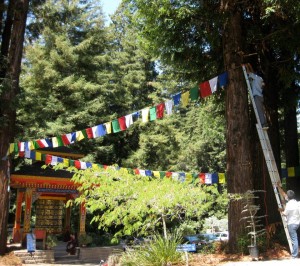
Hanging prayer flags at Land of Medicine Buddha, August 21, 2013. Photo courtesy of LMB’s Facebook page.
The center celebrated Chokhor Duchen with a Shakyamuni Buddha puja and the liberation of 1,400 worms, the merit of which was dedicated to Lama Zopa Rinpoche’s good health, and quick and full recovery. Many more teachings and pujas took place over July and August.
On August 21, which was a full moon day, the day His Holiness the Dalai Lama finished his three-week retreat in Ladakh, India, and a Wednesday, which is a special day for His Holiness astrologically, LMB’s community of students, staff and local Tibetans gathered to perform the sang (incense) offering and made prayers advised by His Holiness for the Tibet cause and offered prayers for the long lives and good health of His Holiness the Dalai Lama and Lama Zopa Rinpoche and for all their holy wishes to be fulfilled.
Then they hung many Tendrel Nyesel prayer flags as advised by Khandro-la for Rinpoche’s health and long life. These prayer flags were designed by Lama Zopa Rinpoche.
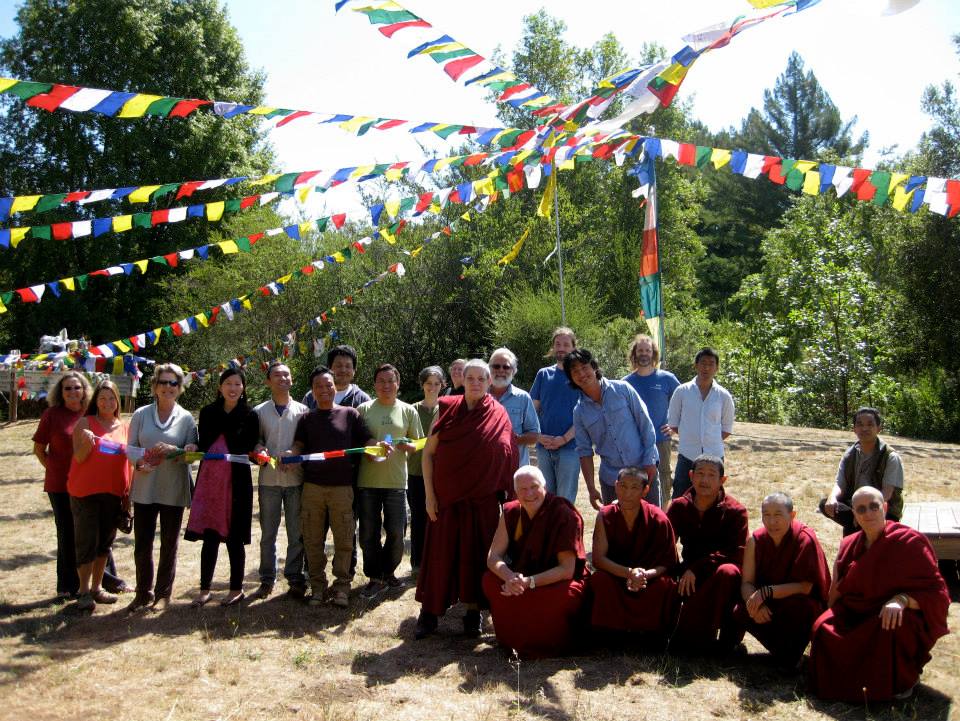
LMB community members after hanging new prayer flags, August 21, 2013. Photo courtesy of LMB’s Facebook page.
You can see more photos and learn more about the activities of Land of Medicine Buddha by visiting them on Facebook.
Mandala brings you news of Lama Zopa Rinpoche and FPMT activities, teachers and events from over 160 FPMT centers, projects and services around the globe. If you have news you would like to share, please let us know.
- Tagged: land of medicine buddha, prayer flags
- 0
21
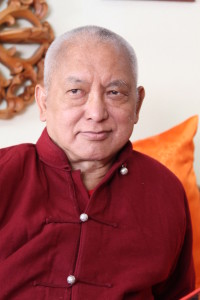
Lama Zopa Rinpoche in a Mongolian jacket, Ulaanbaatar, Mongolia, August 19, 2013. Photo by Ven. Roger Kunsang.
Live and recorded webcasts of Lama Zopa Rinpoche teaching during the 100 Million Mani Retreat in Mongolia can be watched on FPMT’s livestreaming webpage.
Several videos of Rinpoche’s teachings, the first from August 16, have already been posted. Rinpoche will continue offering teachings that will be streamed live through the end of the month. The recordings of the teachings will also be made available to watch later.
The teachings are taking place at the 100 Million Mani Retreat. FPMT Mongolia organized the retreat, which is being held at Idgaa Choizinling Dratsang (College), Gandan Monastery, Ulaanbaatar, Mongolia.
Check the FPMT Facebook page for updates on new webcasts. You can find photos from the Mongolia retreat on the FPMT Facebook page as well as the FPMT Mongolia Facebook page.
Mandala brings you news of Lama Zopa Rinpoche and FPMT activities, teachers and events from over 160 FPMT centers, projects and services around the globe. If you have news you would like to share, please let us know.
20
Shopping Buddha
Sarah Shifferd reflects on how Buddhist ethics can positively affect how and what we buy:
… I show the candy bar to my mother, my best pleading look on my face. “Mommy?” She looks down. “No. We – we don’t buy those.” Even tighter face. “That’s a bad company. They make babies sick.” She searches my face. “I’ll explain later.”
I gently return the beautiful package to its place and stare at it. The horror of my mother’s words crash against the utter perfection of the object in front of me. Babies cough and drown in the blue banner and convulse beneath the red letters. I turn away, sickened and confused.
Moments later, I am zipped up, mittened, and installed in the back seat of our Dodge Aspen station wagon. As Dad pulls out of the parking lot, Mom turns towards me. Nestlé doesn’t only make candy bars, she explains; they also make food for babies called infant formula. They persuade women in Africa to feed their babies formula instead of breast milk, and that’s wrong.
I argue with her. Maybe formula is better. I wasn’t breastfed and I turned out okay.
She faces me directly. Nestlé tricked the women by giving them formula for free in the beginning. The women’s breast milk dried up and they had no choice but to buy formula they couldn’t afford. Their babies went hungry. And the women didn’t have clean water to mix with the formula, so their babies got sick and some even died. Nestlé knew this, but they kept tricking the women into buying formula anyway.
Mom looks at me hard. “We don’t give our money to companies that hurt people,” she says. “If enough people boycott them, they won’t make as much money. Then maybe they’ll change.”
Mom faces forward and discusses the workday with my father. I watch Lake Superior pass by my window and try to shake the nausea that envelops me. Neatly suited men stand around a large table in a Nestlé blue room, congratulating each other as skinny babies gasp and whimper on a screen behind them. A man turns and offers me a Nestlé Crunch bar. He laughs when I flinch.
From Mandala July-September 2013
- Home
- News/Media
- Study & Practice
- About FPMT Education Services
- Latest News
- Programs
- New to Buddhism?
- Buddhist Mind Science: Activating Your Potential
- Heart Advice for Death and Dying
- Discovering Buddhism
- Living in the Path
- Exploring Buddhism
- FPMT Basic Program
- FPMT Masters Program
- FPMT In-Depth Meditation Training
- Maitripa College
- Lotsawa Rinchen Zangpo Translator Program
- Universal Education for Compassion & Wisdom
- Online Learning Center
- Prayers & Practice Materials
- Overview of Prayers & Practices
- Full Catalogue of Prayers & Practice Materials
- Explore Popular Topics
- Benefiting Animals
- Chenrezig Resources
- Death & Dying Resources
- Lama Chopa (Guru Puja)
- Lama Zopa Rinpoche: Compendium of Precious Instructions
- Lama Zopa Rinpoche: Life Practice Advice
- Lama Zopa Rinpoche Practice Series
- Lamrim Resources
- Mantras
- Prayer Book Updates
- Purification Practices
- Sutras
- Thought Transformation (Lojong)
- Audio Materials
- Dharma Dates – Tibetan Calendar
- Translation Services
- Publishing Services
- Teachings and Advice
- Find Teachings and Advice
- Lama Zopa Rinpoche Advice Page
- Lama Zopa Rinpoche: Compendium of Precious Instructions
- Lama Zopa Rinpoche Video Teachings
- ༧སྐྱབས་རྗེ་བཟོད་པ་རིན་པོ་ཆེ་མཆོག་ནས་སྩལ་བའི་བཀའ་སློབ་བརྙན་འཕྲིན།
- Podcasts
- Lama Yeshe Wisdom Archive
- Buddhism FAQ
- Dharma for Young People
- Resources on Holy Objects
- Ways to Offer Support
- Centers
- Affiliates Area
- Teachers
- Projects
- Charitable Projects
- Make a Donation
- Applying for Grants
- News about Projects
- Other Projects within FPMT
- Support International Office
- Projects Photo Galleries
- Give Where Most Needed
- FPMT
- Shop
Subscribe to FPMT News
Translate*
*powered by Google TranslateTranslation of pages on fpmt.org is performed by Google Translate, a third party service which FPMT has no control over. The service provides automated computer translations that are only an approximation of the websites' original content. The translations should not be considered exact and only used as a rough guide.Without understanding how your inner nature evolves, how can you possibly discover eternal happiness? Where is eternal happiness? It’s not in the sky or in the jungle; you won’t find it in the air or under the ground. Everlasting happiness is within you, within your psyche, your consciousness, your mind. That’s why it’s important that you investigate the nature of your own mind.







